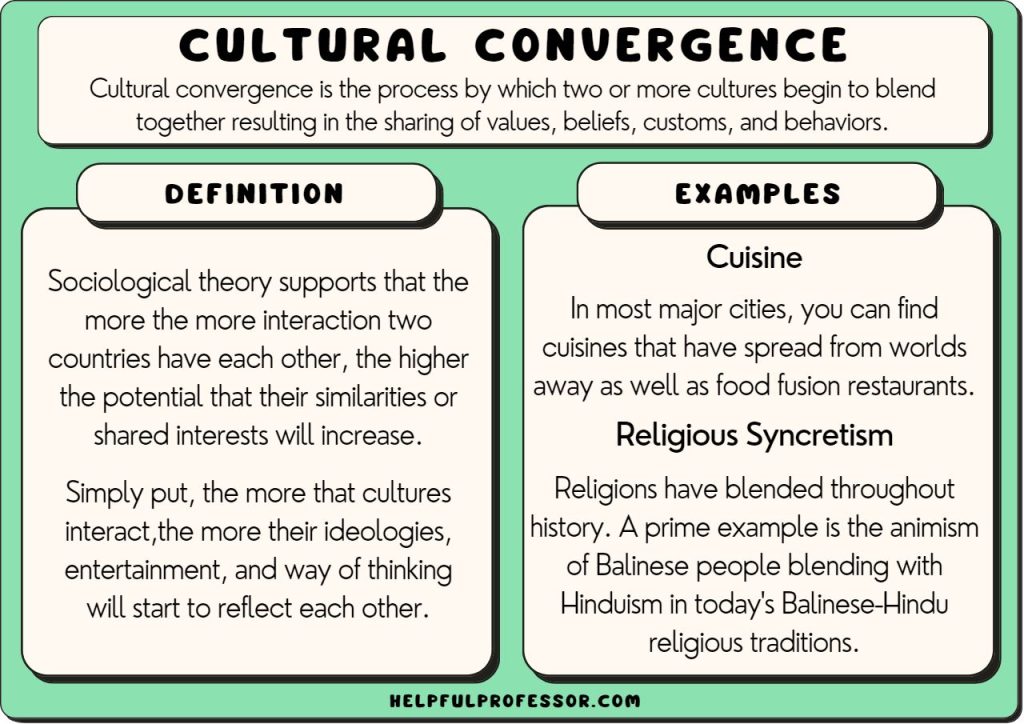Cultural hybridization represents a fascinating phenomenon where distinct cultural elements amalgamate, giving rise to unique expressions in various domains, including food, music, art, and fashion. This intricate blending often promises to offer novel perspectives, enriching our global culture while invoking a sense of curiosity about the ways in which cultures interact and evolve. Indeed, examining examples of cultural hybridization allows us to delve into the complexities of identity and community in an increasingly interconnected world.
Food, arguably one of the most significant cultural touchstones, illustrates the dynamics of hybridization vividly. Consider the rise of fusion cuisine, which deftly combines culinary traditions from disparate cultures. Sushi burritos, for instance, merge the flavors of traditional Japanese sushi with the casual, hand-held aesthetics of a Mexican burrito, resulting in a delightful culinary concoction that engages the consumer in unexpected taste combinations. This not only showcases the adaptability of culinary practices but also highlights how cultural elements can transcend geographical boundaries, leading to innovative gastronomic experiences.
Moreover, the advent of globalization has contributed to a proliferation of food trucks and pop-up eateries that experiment with hybrid culinary forms, crafting dishes that reflect the diverse backgrounds of their chefs. For instance, Korean tacos bring together Korean BBQ and traditional Mexican ingredients, exemplifying how cultural exchange can produce gastronomic marvels. Herein lies a promise: such hybrid foods challenge preconceived notions of authenticity and inspire communities to embrace diversity through shared culinary experiences.
Music serves as another compelling arena for observing cultural hybridization in action. Genres like reggae fusion and Latin pop seamlessly blend elements from various musical traditions, creating vibrant sounds that resonate with a global audience. Bob Marley’s influence, for instance, catalyzed an explosion of reggae-inspired music across cultures, infusing local sounds with his unmistakable rhythm and themes of social justice. Similarly, the emergence of reggaeton—a genre that fuses Latin rhythms with hip-hop and R&B influences—illustrates how hybridization in music can cross cultural divides, uniting listeners in shared experience.
In the realm of hip-hop, artists of diverse backgrounds have innovated by incorporating traditional instruments and local dialects into their tracks. This practice not only showcases the eclectic nature of modern music but also serves as a testament to the ways culture informs creativity. By transcending cultural boundaries, musicians foster an environment of inclusivity where cross-genre collaborations become commonplace, enabling the discovery of new artistic expressions.
Visual arts also reflect cultural hybridization through the interplay of various artistic styles and influences. The contemporary art movement has seen artists draw inspiration from indigenous techniques while integrating modern art forms, creating works that resonate on multiple levels. For example, artists like Ai Weiwei amalgamate traditional Chinese aesthetics with contemporary issues, illustrating the hybrid nature of identity in a globalized world.
Additionally, urban spaces often epitomize cultural hybridization, acting as melting pots where different cultures converge. Cities like New York, London, and Tokyo exemplify vibrant examples of multiculturalism, where artistic expressions, culinary delights, and social practices intersect. Street art, fashion, and performances found in public spaces often reflect the hybridization of cultures, showcasing a rich tapestry of life that continually evolves. This phenomenon not only fosters a dynamic cultural landscape but also inspires curiosity about everyday interactions and the narratives behind them.
The digital age has further accelerated cultural hybridization, particularly through social media platforms where diverse cultural expressions can be shared immediately and widely. Viral trends often originate from unique cultural fusions, whether they are dance challenges that integrate styles from various traditions or meme cultures that reflect shared global experiences. This fast-paced exchange of ideas fosters an environment where curiosity is piqued, prompting global conversations around identity and cultural significance.
However, while cultural hybridization offers numerous benefits, it is essential to approach this phenomenon with a nuanced perspective. The risk of cultural appropriation—a process where elements of a culture, often marginalized, are taken and commodified by another—raises ethical questions about the ownership of cultural expressions. It is imperative to engage in these conversations with respect for cultural heritage, acknowledging contributions and historical contexts to ensure that hybridization does not lead to erasure or misrepresentation of the originating culture.
Education plays a crucial role in navigating these complexities. By fostering open dialogue and promoting awareness of the historical and social frameworks that shape hybrid cultural expressions, a deeper understanding can emerge. Institutions, educators, and community leaders can cultivate spaces for learning, reflection, and critical engagement, encouraging individuals to appreciate the richness and diversity of cultural interactions.
In conclusion, cultural hybridization exemplifies the dynamic interplay of cultural elements, enriching our global identity. Through food, music, art, and urban experiences, hybridization not only showcases creativity and innovation but also promises to foster curiosity about the diverse world we inhabit. While there are complexities and ethical considerations to navigate, the vast potential that arises from these cultural interactions invites us to celebrate diversity, challenge the status quo, and inspire a deeper understanding of our shared humanity. As we move forward in a globalized world, embracing cultural hybridization may ultimately lead to a more inclusive and empathetic society.
